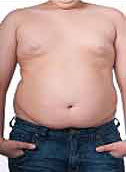
MONDAY, Nov. 10, 2014 (HealthDay News) — The vast majority of children who are obese at age 11 are still far too heavy at age 16, new research suggests.
Tracking nearly 4,000 children in three U.S. metropolitan areas over five years, researchers found that 83 percent of obese 10th graders had also been obese in fifth grade. Only 12 percent of kids who were obese in fifth grade transitioned to a normal weight over the following half-decade, according to the study.
“Parents sometimes think that it’s just baby fat and their kids will outgrow it, but we found a lot more constancy [of extra weight over time] than we anticipated,” said study author Dr. Mark Schuster, chief of general pediatrics at Boston Children’s Hospital.
“Certainly, once you’ve gained weight and become obese or overweight, it’s harder to change the habits influencing that,” he added. “But just because kids are gaining weight as they get older doesn’t mean they can’t lose weight — they definitely can.”
The study was published online Nov. 10 and in the December print issue of the journal Pediatrics.
Obesity has more than doubled in children and quadrupled in adolescents in the past three decades, according to the U.S. Centers for Disease Control and Prevention. About 18 percent of children aged 6 to 11 and 21 percent of adolescents aged 12 to 19 are obese, the CDC says.
Prior research has indicated that overweight children are at least twice as likely as normal-weight kids to be overweight as adults, and up to 90 percent of obese adolescents become overweight or obese adults. A weight-height calculation of body-mass index (BMI) above 25 is considered overweight, while a BMI over 30 is classified as obese.
Schuster and his colleagues randomly selected almost 4,000 public school students in Birmingham, Ala., Houston and Los Angeles County, Calif., measuring them and a parent for height and weight in fifth and 10th grades. The participants were chosen to provide a balanced sample of blacks, whites and Latinos.
About 53 percent of participants were normal weight in fifth grade, and 45 percent were overweight or obese, the researchers found.
While most obese 10th graders had been obese in fifth grade, the stability of children’s weight over time was also demonstrated by 87 percent of normal-weight fifth-graders remaining a normal weight five years later, according to the study.
Obese fifth-graders were more likely to stay obese in 10th grade if they perceived themselves to be much heavier than ideal or came from a less educated household, the study showed.
Comparing overweight fifth-graders who became obese by 10th grade and those who didn’t, it also suggested that children were more likely to pack on even more pounds over time if they watched more TV or had a parent who was obese at the start of the study.
“We’ve known for some time that obesity, once it develops, can persist from childhood into adolescence and adulthood,” said Dr. Stephen Daniels, pediatrician-in-chief of Children’s Hospital Colorado.
“What’s interesting to see here is that it’s not a uniform thing . . . clearly there are kids who maintain [obesity], and others lose it,” Daniels added. “So, I don’t think the study is totally surprising, though it’s instructive in some ways.”
Other factors possibly influencing the obesity trend in young people include the “normalization” of carrying extra weight among the entire population, Schuster said.
“If children look around them, they’re seeing on average a more obese group of kids than 40 years ago, and their parents are as well,” he said. “So there is a sort of social normalization of having a higher BMI, and it’s just a much more common experience. That certainly could be contributing to this.”
Schuster and Daniels agreed that pediatricians and parents need to pinpoint behaviors — among both kids and parents — that lead to weight gain and target them individually.
“People are less likely to walk places or go to a park,” Schuster said. “There’s also a lot of fast, convenient, high-processed food available that’s higher in calories and less nutritious. A lot of what we’re trying to encourage is to eat a healthier diet and engage in more physical activity — and that’s true whether a child is obese or not.”
Schuster added that parents can readily encourage a healthy weight among their children without tipping them into becoming overly body-conscious or developing an eating disorder.
“We don’t want to give our kids a Barbie and say, why don’t you look like her? The idea is to not be getting our kids through the day on chips and candy,” he said. “It’s to provide them healthy foods and not think that fast foods and processed foods are what food is. They can walk with them to school, play in the backyard with them and turn off the TV.”
More information
The U.S. Department of Agriculture offers information and guidance on childhood and adolescent obesity.
Copyright © 2025 HealthDay. All rights reserved.

